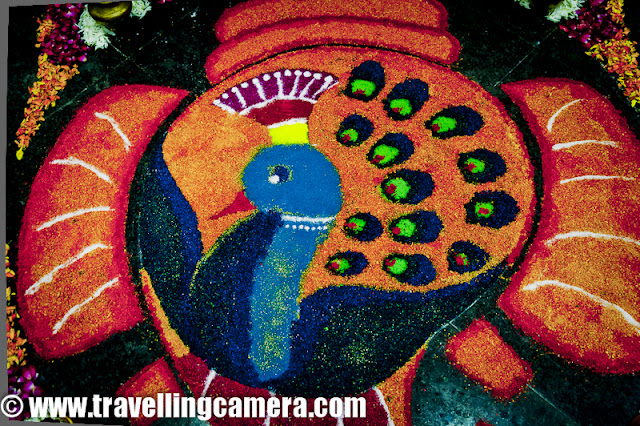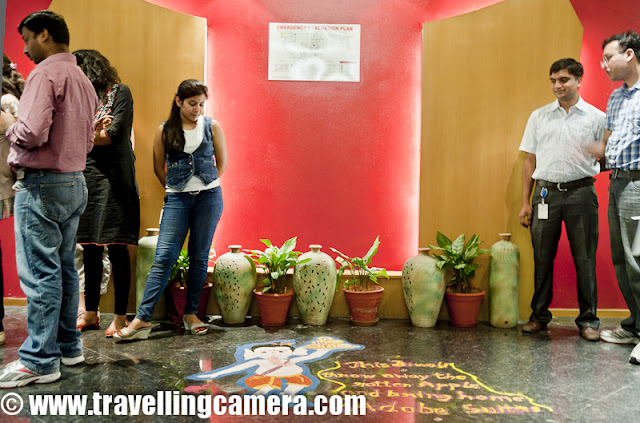
Rangoli is a traditional decorative folk art of India. These are decorative designs made on floors of living rooms and courtyards during Hindu festivals and are meant as sacred welcoming areas for the Hindu deities. The ancient symbols have been passed on through the ages, from each generation to the one that followed, thus keeping both the art form and the tradition alive. Rangoli and similar practices are followed in different Indian states; in Tamil Nadu, one has Kolam, Madanae in Rajasthan, Chowkpurna in Northern India, Alpana in Bengal, Aripana in Bihar, and so on. The purpose of Rangoli is decoration and it is thought to bring good luck. [Courtesy: Wikipedia. Click here to read more]
Teams make rangolis every year before Diwali at Adobe India. However, this time the patterns were incredibly intricate and imaginative.
Om (ॐ) is the sacred symbol of Hinduism, Buddhism, and Jainism and can often be seen in religious arts. Rangoli is no exception.
The traditional rending of a new bride in a Doli. In medieval and ancient India and for a long time even in modern India, after marriage, dolis bourne on the shoulders of 4-6 men were used to transport the new bride
to her husband's home.
Related post - Diwali Preparations at my Home
to her husband's home.
Related post - Diwali Preparations at my Home
Marigold flowers (गेन्दा) are inseparable from Hindu Prayers and religios decorations. Idols of Deities are often adorned with garlands of marigold flowers and red roses.
This is a clever integration of a peacock in the face of Lord Ganesh. While the peacock is the greatly revered in Hindu Scriptures, Lord Ganesh is the deity who the Hindus rely upon to take care of new entreprises.
Beautiful colors and image! The peacock is also the National Bird of India.
A pattern with the peacock in the center and outlined with marigold and rose petals.
Related post - Diwali celebrations have changed over the years and I am enjoying it more with my family now
Related post - Diwali celebrations have changed over the years and I am enjoying it more with my family now
A Peacock is often referred to as a bird with a hundred eyes owing to the eye-like patterns in its tail feathers.
The Kalash (a brass pot) is a symbol of abundance in Hinduism. It is often worshipped during the yagyas along with the deities in Arya Samaj branch of Hinduism.
Full rendering of a peacock on the branch of a flowering plant with symbols of various Adobe Products in its tail. It is holding a scroll with the symbol of Adobe and the Sacred Swastik in its beak. Swastik, contrary to common knowledge, is an ancient holy symbol in Hinduism. Unfortunately, it was used by Nazis and after that the real, holy meaning seems to have been lost to the world. But in India, it is still used with a lot of respect in almost all religious ceremonies.
Lord Ganesh with his elephant head and human body. Lord Ganesh is widely worshipped along with Goddess Lakshmi (the Godess of Wealth) during diwali. Lord Ganesh, himself, is considered to be the God of New Beginnings, someone who removes hurdles.
Another colorful design with the logos of various Adobe products, You can see the well know photoshop, Premiere Pro, Dreamweaver, Acrobat, InDesign etc.
Diya's (earthen lamps) are used during diwali to decorate houses and businesses. They are shallow vessels made of clay or brass and have a cotton wick dipped in mustar oil.
This design is more traditional with Om and a stark white color against a bright red.
Two peacocks with their royal blue necks and bright green plumage. Peacocks seemed to rule the designs this year.
A new age Ganesh with his vehicle, a mouse. If you look closely, the mouse if offering him an Apple that looks strikingly similar to the logo of the Software Giant of the same name. While the word Adobe has been written in a calligraphic script at the top. Cheeky!
A close-up of the Kalash. This one is earthern but has been paited over with a metallic paint. Around it are typical colors of Hinduism, saffron and yellow.
A close-up of the calligraphic Adobe.
Baby Ganesh, floating on a cloud, over a colorful carpet of Adobe Products. Whether this cloud is a spiritual cloud or the technical cloud, is open to interpretations.
Another colorful and elaborate design with Ganesh and Swastik, The shape of a mango is another common shape in Indian arts. You'll find it used in abundance in mehndis (henna tattoos) and rangolis.
Photoshop, flash, Dreamweaver, Bridge and other Adobe products around an Adobe symbol.
A fancy earthen Diya full of blue rangoli color.
Lord Ganesh, in his various forms, has inspired many artists. And as a result, his form has been used extensively in all kinds of arts, starting from Rangoli to paintings to sculpting.
Simple, yet pretty.
Adobe employees admiring one of the rangolis.
Elephant, another symbol of Hinduism. This one's a tusker and is carrying Adobe on its back. Elephants are closely related to Lord Ganesh.
The Rangolis are as colorful as Adobe itself. This particular Rangoli is of a dancing Lord Ganesh.



























.jpg)
Comments
The one in Bihar is called Aiirpan. Sell these pics to their creators. :-)
I have been receiving various calls since morning... I think HR can pay on behalf of all :)
http://summersofindia.blogspot.com/
Since I post about traditional rangolis, I feel that these modern rangolis would also be appreciated by those who visit my blog for Rangolis
Ms Sharma
Anika - Did you try any of these during Diwali-2011
Anchita - Thanks for liking clicks and of course designs were awesome !
Poonam - Thanks for liking the clicks :)
Ashish - ha ha... Your pic shows you are Doc but comment says you are an Engineer :) .. Anyways, Android Rangoli was good...
Ms Sharma - Liked your blog !
Cheers xxxx
Akhila
Rangoli designs with dots